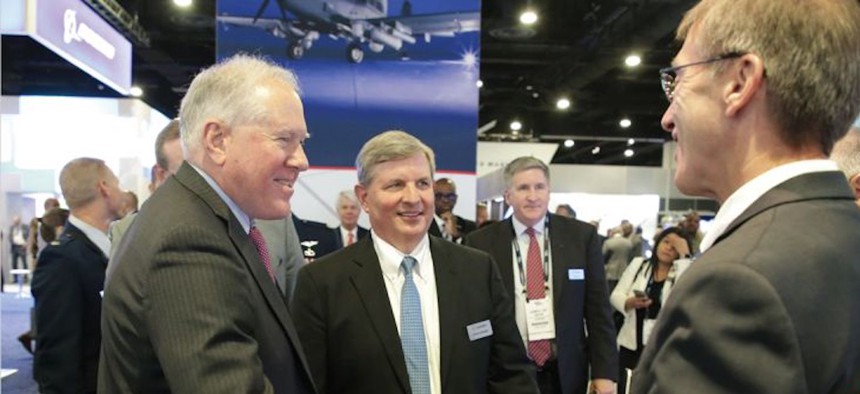
Chris Kubasik, CEO of L3Harris Technologies (center) and Air Force Secretary Frank Kendall (left) speak to Sean Stackley, L3Harris senior vice president for strategy and growth (right) at the Air and Space Forces Association's Air, Space & Cyber conference. L3Harris via LinkedIn
After Big Pentagon Contract Wins, L3Harris CEO Eyes More Growth
Three years after merger of L3 Technologies and Harris, the company is striving to “compete on a level playing field,” CEO Kubasik says.
When L3 Technologies and Harris Corp. merged in 2019, executives touted lofty goals of competing against the largest defense firms. Three years later, L3Harris Technologies is winning Pentagon deals worth billions of dollars, and its CEO Chris Kubasik envisions even more growth.
“We're punching above our weight, and we need to continue to grow, including acquisitions, to get to scale, to be able to compete on a level playing field,” Kubasik said in an interview.
When Kubasik became CEO of L3 Technologies in January 2018, he wanted to change the firm’s culture to make it operate more like a commercial technology company, as opposed to a bureaucratic government contractor. He’s taken that same approach as CEO of the combined company, a position he has held since June 2021, pitching it to the military as a “trusted disruptor,” meaning it’s a known quantity to the Pentagon, but operates differently than other defense firms.
In a two week period this past summer, L3Harris won three high-profile contacts with more than $4 billion. The largest came on Aug. 1 when L3Harris—in partnership with crop duster maker Air Tractor—beat out other established planemakers to secure a U.S. Special Operations Command contract that could be $3 billion for up to 75 attack planes.
A few weeks before it won the SOCOM contract, L3Harris won a $700 million Pentagon contract to build missile tracking satellites that can track fast-flying hypersonic weapons. It also won a $380 million Navy deal to provide a key system that lets ships know what’s around them so they can track and strike a target.
“Everybody talks about talking to their customer, I emphasize the importance of listening to your customer, which actually is a pretty big difference,” Kubasik said. “We've listened to what the requirements are [and] we listen to what the threats are.”
The company views itself as being “platform agnostic”—meaning it could do heavy modifications to Gulfstream-made business jets, like it did for the Air Force EC-37B Compass Call, or a Bombardier business jet, as it did for Army reconnaissance and electronic warfare aircraft.
“We had the ability to go out, being platform agnostic, and finding the best platform available for the mission … and then making the investments on the key technologies and [demonstrating] it,” Kubasik said.
L3Harris is the sixth largest U.S. defense contractor behind Lockheed Martin, Raytheon Technologies, Boeing, Northrop Grumman, and General Dynamics—also known as the “Big 5” or “primes contractors.” When L3 and Harris merged, Kubasik and Harris CEO Bill Brown, who was CEO of the combined company for its first two years, hoped to create a “sixth prime.”
“I think it all ties into this, this strategy of doing more and more prime work,” Kubasik said. “Ultimately, the goal of the L3-Harris merger was to provide competition and give our DOD customers more alternatives.”
While the strategy appears to be working, L3 is still far smaller than five firms at the top of the defense contractor revenue list. L3Harris’ 2021 defense revenue of about $15 billion was about half of No. 5 General Dynamics, which booked nearly $31 billion, according to Defense News.
It’s also looking to partner with non-traditional firms. In March it formed a strategic partnership with Shield Capital, a Silicon Valley-based venture capital firm that invests in startups that have technology beneficial to both the commercial and national security sectors.
“What we've tried to do is remain open minded and partner where it made sense, either as a prime or [subcontractor].” Kubasik said. “A lot of my time and effort is focused on working with these new entrants that are a little more software- [and] AI-enabled.”
An area of potential growth for the company is nuclear command, control, and communications—technology that’s used to transmit nuclear weapons data between command centers, satellites, aircraft, submarines, and missile silos. Asked if the company wants to be a part of the Air Force’s plans to buy new E-4B nuclear command planes, Kubasik said: “Absolutely.”
Still, the company is facing the same workforce, supply chain, and inflation issues impacting all sectors of manufacturing. In an effort to relieve inflationary pressures on its workers, it’s not raising its employee benefit contributions, and it’s increasing merit raises.
Throughout the pandemic, it allowed workers who can work remotely to do so. It also adopted a 9/80 work schedule. That’s left empty office space that the company is looking to lease or sell.
“There’s a lot of things going on in the world [and] we can only control so much of those things,” Kubasik said. “So let’s focus on what that is.”




